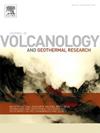Petrogenesis and residence times of trachyte magma at Água de Pau volcano (São Miguel, Island, the Azores): insights from the geochemistry of alkali-feldspars and hosted melt inclusions
IF 2.3
3区 地球科学
Q2 GEOSCIENCES, MULTIDISCIPLINARY
Journal of Volcanology and Geothermal Research
Pub Date : 2025-07-26
DOI:10.1016/j.jvolgeores.2025.108413
引用次数: 0
Abstract
Major and trace element composition of sanidine and anorthoclase minerals and of the hosted melt inclusions (MI) from two important pumice fallout eruptions (Fogo A and AD1563) of Água de Pau volcano (São Miguel island, Azores) were investigated to define the features of the source feeding the volcano and to fix the timescales of petrogenetic processes previous to these eruptions.
The major element data in minerals and related MI evidenced that Fogo A magma erupted ∼4500 yr BP at 980 °C and contained on average H2O = 5.2 wt% whereas the 1563 CE magma erupted at 799 °C and contained H2O = 4.6 wt%. Also, the variable Rb/Sr (2.86–36.97), Nb/Y (3.52‐7.92) and La/Th (2.32–5.77) in melt inclusions of feldspars highlighted the effect of fractional crystallization of a trachytic magma, which periodically mixed with a more mafic component having a composition comparable to that erupted in Água de Pau. The estimated volume of the mafic magma associated with the Fogo A eruption (∼10 %), is larger than that associated with the 1563 CE event.
Compositional profiles across feldspars revealed magma ponding times of ∼32 kyr and 6–16 kyr for the Fogo A and the 1563 CE eruptions, respectively. These estimations showed that probably these two volcanic events interested two different portions of the same magmatic system, with the oldest eruption involving a deeper and wider magma volume. This is corroborated by the different magnitudes of the two eruptions. Also, the same magma batch has likely fed both eruptions studied in this work and those strictly preceding.
Água de Pau火山(s o Miguel,亚速尔群岛)粗支岩岩浆的岩石成因和停留时间:来自碱长石和含矿熔融包裹体的地球化学见解
研究了Água de Pau火山(亚速尔群岛 o Miguel岛)两次重要浮石沉降喷发(Fogo A和AD1563)中浮石和斜长石矿物以及承载的熔融包裹体(MI)的主要和微量元素组成,以确定火山补给源的特征,并确定这些喷发前岩石形成过程的时间尺度。矿物主要元素数据和相关MI证明,Fogo A岩浆在980°C喷发~ 4500 yr BP,平均含水5.2%,而1563 CE岩浆在799°C喷发,平均含水4.6 wt%。此外,长石熔体中Rb/Sr(2.86 ~ 36.97)、Nb/Y(3.52 ~ 7.92)和La/Th(2.32 ~ 5.77)的变化也表明了粗溶岩浆的分晶作用,该岩浆周期性地与更具基性的成分混合,其组成与Água de Pau火山喷发的成分相当。与Fogo A喷发相关的基性岩浆的估计体积(约10%)大于与1563 CE事件相关的岩浆体积。长石的成分剖面显示,Fogo A和1563 CE喷发的岩浆沉积时间分别为~ 32 kyr和6 ~ 16 kyr。这些估计表明,这两次火山事件可能涉及同一岩浆系统的两个不同部分,其中最古老的喷发涉及更深更广的岩浆量。两次喷发的不同震级证实了这一点。此外,同样的岩浆可能为本研究和之前研究的两次喷发提供了动力。
本文章由计算机程序翻译,如有差异,请以英文原文为准。
求助全文
约1分钟内获得全文
求助全文
来源期刊
CiteScore
5.90
自引率
13.80%
发文量
183
审稿时长
19.7 weeks
期刊介绍:
An international research journal with focus on volcanic and geothermal processes and their impact on the environment and society.
Submission of papers covering the following aspects of volcanology and geothermal research are encouraged:
(1) Geological aspects of volcanic systems: volcano stratigraphy, structure and tectonic influence; eruptive history; evolution of volcanic landforms; eruption style and progress; dispersal patterns of lava and ash; analysis of real-time eruption observations.
(2) Geochemical and petrological aspects of volcanic rocks: magma genesis and evolution; crystallization; volatile compositions, solubility, and degassing; volcanic petrography and textural analysis.
(3) Hydrology, geochemistry and measurement of volcanic and hydrothermal fluids: volcanic gas emissions; fumaroles and springs; crater lakes; hydrothermal mineralization.
(4) Geophysical aspects of volcanic systems: physical properties of volcanic rocks and magmas; heat flow studies; volcano seismology, geodesy and remote sensing.
(5) Computational modeling and experimental simulation of magmatic and hydrothermal processes: eruption dynamics; magma transport and storage; plume dynamics and ash dispersal; lava flow dynamics; hydrothermal fluid flow; thermodynamics of aqueous fluids and melts.
(6) Volcano hazard and risk research: hazard zonation methodology, development of forecasting tools; assessment techniques for vulnerability and impact.

 求助内容:
求助内容: 应助结果提醒方式:
应助结果提醒方式:


